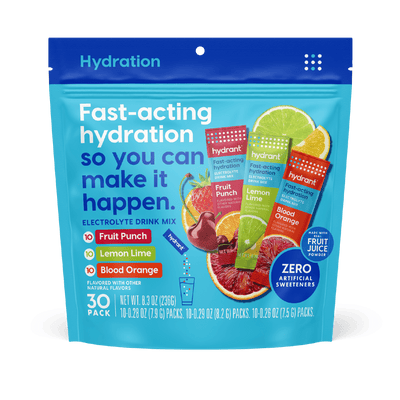Runners and cyclists know how much of a battle it is to fight hydration. Your body is made up of 50-60% water, and strenuous exercise is a fast way to deplete those liquid reserves and leave you feeling brittle and weak. Sweating and even breathing, both of which emit water vapor, force endurance athletes to constantly refuel with effective hydration to keep both their physical and mental states up to speed.
When endurance training, dehydration can set in very quickly. The best way to stay sharp and active is to proactively hydrate with water and the right balance of electrolytes. Even a moderate one-hour hike could lead to 2% dehydration, which is the equivalent to sweating out an entire liter of water. But by this point, your body will only just start to tell you it needs water by making you thirsty. Though hard to notice, it’s best to hydrate before thirst sets in with water and electrolyte-infused sports drinks.

As your muscles work, they create heat. Your body doesn’t want excess heat, so you sweat to cool off. Just regular water isn’t always the best way to refuel if you’re working out intensely or if you’re a heavy sweater. Pure water contains no salt, so your salt levels will be thrown off as you sweat. Instead of replenishing electrolytes naturally from your food, you may need an extra boost of electrolytes from sports drinks to keep up.
1. Muscle Fatigue

We’ve all felt muscle fatigue–when your limbs suddenly feel as though they’re filled with lead no matter how hard you try to move them. Sometimes muscle fatigue comes on quicker than we expect. This is usually due to an imbalance of electrolytes, such as sodium and potassium, in your body, which stems from improper or too little hydration. Running a marathon or biking many miles without proper hydration will cause your muscles to work less efficiently and cramp up more easily.
2. Health Risks
There are so many health risks associated with dehydration that it’s difficult to list them all. The major ones include rapid breathing, fever, vomiting, headaches, low blood pressure, sunken eyes, shriveled skin, dizziness, fatigue, and lack of sweat production. Simply put, dehydration is one of the most dangerous conditions for your body, and endurance sports only accelerate how quickly you can get dehydrated.
3. Lower Cognition
Cognition, or how your brain learns, processes, and understands information, is heavily related to the level of hydration in your body. The more dehydrated you are, the lower your cognition will probably be. Your decision making skills will be thrown off and you may experience impairment in activities requiring mental focus, motor coordination, and attention. For runners and cyclists, this means losing that much-needed concentration to push through the pain of hitting “The Wall” and keeping up the pace.
4. Dry Mouth

We’ve all experienced it: the irritating sensation of your mouth feeling like it’s made of sandpaper. One of the most physical symptoms of dehydration, dry mouth is exasperated in particularly hot conditions as you sweat more and if you breathe with an open mouth while running or cycling.
To ensure that you don’t have a lousy performance while training or racing, create a hydration plan for hydration. First, calculate your sweat rate. The best way of doing this is to weigh yourself without clothes before going for an hour run or an hour bike ride. After this hour, note the temperature and humidity levels, and then weigh yourself again without clothes. If you drank nothing during the workout, your sweat rate is simply how much weight you lost. If you had fluids, add the number of ounces you drank to the difference in weight. One pound equals 16 ounces of fluids lost. So, if you lost one full pound after working out but you drank a 16.9 ounce bottle of water, you actually lost approximately 33 fluid ounces, or 2 pounds.
However, knowing your sweat rate is only a ballpark of how much you have to rehydrate while working out. It used to be common advice to replenish every ounce of sweat with an ounce of water, but large amounts of water without electrolytes is pretty dangerous. It could lead to hyponatremia, meaning that your body has a low sodium concentration and needs salt levels to be rebalanced through electrolyte-infused sports drinks.
Get your body back in balance with Hydrant, an electrolyte mixed designed to help you perform.
















